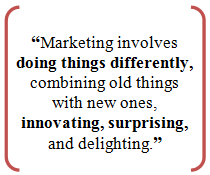Creative Problem Solving for Marketers
Editor’s note: We’re pleased to welcome Minna-Maarit Jaskari of the University of Vaasa, Finland, whose article “The Challenge of Assessing Creative Problem Solving in Client-Based Marketing Development Projects: A SOLO Taxonomy Approach” is forthcoming in the Journal of Marketing Education and now available in the journal’s OnlineFirst section.
 My paper is about assessing creativity in student work. I work in marketing and business, and we see creativity and innovativeness as extremely important for business. My own interest lies in understanding consumers and providing value creation opportunities for customers. Marketers often need to be creative in order to provide value for customers. This is why we see it is important to teach creativity and creative problem solving in marketing.
My paper is about assessing creativity in student work. I work in marketing and business, and we see creativity and innovativeness as extremely important for business. My own interest lies in understanding consumers and providing value creation opportunities for customers. Marketers often need to be creative in order to provide value for customers. This is why we see it is important to teach creativity and creative problem solving in marketing.
 Also, from the pedagogical research we know that students tend to learn things they are assessed about. Indeed, if we want to teach creativity, we need to assess it as well. However, this is not easy. Indeed, we quickly need to start thinking, what is creativity in the marketing and business context? In my paper I have focused on creative problem solving. Creativity itself is not enough; in business, we need to be able to implement it and create a marketing concept around it.
Also, from the pedagogical research we know that students tend to learn things they are assessed about. Indeed, if we want to teach creativity, we need to assess it as well. However, this is not easy. Indeed, we quickly need to start thinking, what is creativity in the marketing and business context? In my paper I have focused on creative problem solving. Creativity itself is not enough; in business, we need to be able to implement it and create a marketing concept around it.
My paper focuses on analyzing a very interesting tool, SOLO taxonomy for marketing contexts. The background of the taxonomy goes into cognitive thinking and deep understanding. I have proposed a framework to assess creative problem solving in the marketing context. Such frameworks have not been established to date.
The most surprising result for me was that creativity tied with usefulness really occurred in the higher level of understanding. Even if we know from the literature that creativity requires hard work, this analysis proved the same. For me as a teacher, it gives assurance to actively require students to work hard. Also, the highest level of understanding — the extended abstract level — is actually quite difficult to achieve, if not enhanced by the teacher. The school context is difficult, as in that level the students need to put a lot of effort into their work. And as we know, sometimes the real challenge for the teacher is to motivate the students to work hard, even harder than required.
I hope that marketing educators see the value of SOLO taxonomy in enhancing deep, relational understanding. This is what we should aim for in higher education. Future research could analyze the use of SOLO in other than client-based projects, such as case studies or learning portfolios.
Read “The Challenge of Assessing Creative Problem Solving in Client-Based Marketing Development Projects: A SOLO Taxonomy Approach” online in the Journal of Marketing Education.




























































































